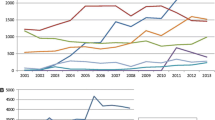Abstract
We report on the findings of an original research initiative to explore current gaps that exist in the level of awareness and utilization of Canada’s adverse drug reaction (ADR) reporting system among community pharmacists. To understand the level of knowledge and practices related to ADR reporting, a survey was conducted among Quebec pharmacists. Nearly two thirds of respondents had reported at least one ADR in the past, but many did not recognize “lack of effectiveness” as an ADR and were unaware of the minimum requirements for ADR reporting. Events seen as “unexpected, rare, or serious” were most likely to be reported whereas “well-known or common” events or those with “uncertain causality” tended not to be reported. Regarding switching from brand name to generic formulation, two thirds reported that they did not perform special monitoring, yet the same proportion recalled a specific ADR associated with switching, particularly with Effexor XR (venlafaxine XR), Pantoloc (pantoprazole), and Concerta (methylphenidate-OROS). The majority of the current survey participants (Quebec pharmacists) are aware of the ADR reporting system, but underutilization exists.
Similar content being viewed by others
References
McGettigan P, Feely J. Adverse drug reaction reporting: opinions and attitudes of medical practitioners in Ireland. Pharmacoepidemiol Drug Saf. 1995;4:355–358
Health Canada. Drugs and health products. Adverse reaction information, http://www.hc-sc.gc.ca/dhp-mps/medeff/advers-react-neg/index-eng.php#a1 (accessed September 7, 2010).
MedEffect Program, www.hc-sc.gc.ca/dhp-mps/medeff/about-sujet-eng.php (accessed August 26, 2010).
Edwards IR, Aronson JK. Adverse drug reactions: definitions, diagnosis, and management. Lancet. 2000;356:1255–1259
Canada Vigilance Adverse Reaction Reporting. http://www.hc-sc.ca/dhp-mps/medeff/vigilance-eng.php (accessed August 26, 2010).
National Association of Pharmacy Regulatory Authorities. Standards of practice for Canadian pharmacists. Pharm Connect. 2010;17(4):12–22
National Association of Pharmacy Regulatory Authorities. National statistics, http://napra.ca/ pages/Practice_Resources/National_Statistics.aspx?id=2103 (accessed January 14, 2011).
National Association of Pharmacy Regulatory Authorities, http://napra.ca/pages/practice_resources/national_statistics_aspx?id=2104/ (accessed July 6, 2011).
Lopez-Gonzalez E, Herdeiro MT, Figueiras A. Determinants of under-reporting of adverse drug reactions: a systematic review. Drug Saf. 2009;32(1):19–31
Hazell L, Shakir SA. Under reporting of adverse drug reactions: a systematic review. Drug Saf. 2006;29(5):385–396
Motola D, Vargiu A, Leone R, et al. Influence of regulatory measures on the rate of spontaneous adverse drug reaction reporting in Italy. Drug Saf. 2008;31(7):609–616
Health Canada. Adverse reaction reporting—survey with health professionals. May 2007. HC POR 06–93.
van Grootheest K, Olsson S, Couper M, et al. Pharmacists’ role in reporting adverse drug reactions in an international perspective. Pharmacoepidemiol Drug Saf. 2004;13:457–464
Canada Vigilance Adverse Reaction Reporting Program. Completion of form instructions. http://www.hc-sc.gc.ca/dhp-mps/alt_formats/pdf/medeff/report-declaration/ar-ei_form-eng.pdf (accessed August 26, 2010).
Burkiewicz JS, Zgarrick DP. Evidence based practice by pharmacists: utilization and barriers. Ann Pharmacother. 2005;39:1214–1219
Brown CM, Barner JC, Shepherd MD. Issues and barriers related to the provision of pharmaceutical care in community health centers and migrant health centers. J Am Pharm Assoc. 2003;43:75–77
Nadaira N, Ouellet C, Rene-Henri N, et al. Factors influencing a community pharmacist’s interventions in asthma care. Can Pharmacists J. 2009;142(5):240–246
Amsler MR, Murray MD, Tierney WM, et al. Pharmaceutical care in chain pharmacies: beliefs and attitudes of pharmacists and patients. J Am Pharm Assoc. 1997;37:535–542
Borgherini G. The bioequivalence and therapeutic efficacy of generic versus brand-name psychoactive drugs. Clin Ther. 2003;25(6):1578–1592
Makus KG, McCormick J. Identification of adverse reactions that can occur on substitutions of generic for branded lamotrigine in patients with epilepsy. Clin Ther. 2007;29(2):334–341
Chenu F, Batten LA, Zernig G, et al. Comparison of pharmacokinetic profiles of brand-name and generic formulations of citalopram and venlafaxine: a crossover study. J Clin Psychiatry. 2009;70:958–966
Vial J, Cohen M, Sassiat P, et al. Pharmaceutical quality of docetaxel generics versus originator drug product: a comparative analysis. Curr Med Res Opin. 2008;24:2019–2033
LeLorier J, Duh MS, Paradis PE, et al. Clinical consequences of generic substitution of lamotrigine for patients with epilepsy. Neurology. 2008;70:2179–2186
Endrenyi L, Tothfalusi L. Do regulatory bioequivalence requirements adequately reflect the therapeutic equivalence of modified release drug products? J Pharm Pharmaceut Sci. 2010;13(1):107–113.
Andermann F, Duh MS, Gosselin A, et al. Compulsory generic switching of antiepileptic drugs: high switchback rates to branded compounds compared with other drug classes. Epilepsia. 2007;48(3):464–469
LeLorier J, Duh MS, Paradis PE, et al. Economic impact of generic substitution of lamotrigine: projected costs in the US using findings in a Canadian setting. Curr Med Res Opin. 2008;24:1069–1081
Nichols V, Theriault-Dube I, Touzin J, et al. Risk perception and reasons for noncompliance in pharmacovigilance: a qualitative study conducted in Canada. Drug Saf. 2009;32:579–590
Health Canada. Underutilization of the adverse reaction reporting system. June 2007 (HC-POR-06-83).
Green CF, Mottram DR, Raval D, et al. Community pharmacists’ attitude to adverse drug reaction reporting. Int J Pharm Pract. 1999;7:92–99
Sweis D, Wong IC. A survey on factors that could affect adverse drug reaction reporting according to hospital pharmacists in Great Britain. Drug Saf. 2000;23:165–172
Author information
Authors and Affiliations
Corresponding author
Rights and permissions
About this article
Cite this article
Rouleau, B., Lavoie, L., Leblanc, J. et al. Reporting of Adverse Drug Reactions by Community Pharmacists: A Qualitative Study in Quebec. Ther Innov Regul Sci 45, 627–639 (2011). https://doi.org/10.1177/009286151104500613
Received:
Accepted:
Published:
Issue Date:
DOI: https://doi.org/10.1177/009286151104500613




